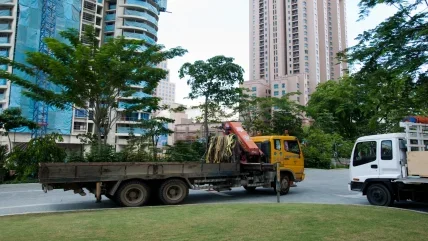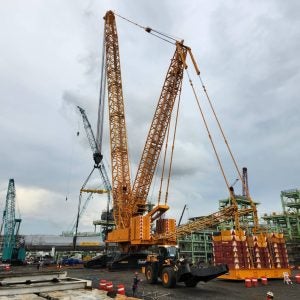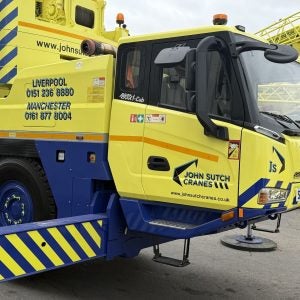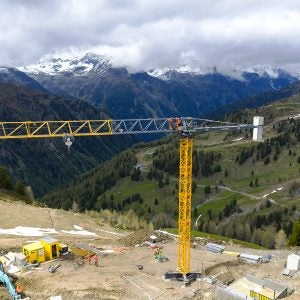
?Australia can rightly be regarded as the home of the pick-and-carry crane. The design was born during World War II, when trailed cranes were the most common type of pick-and-carry crane used in handling stores, with cranes of this type brought to Australia by US forces. The crane section was mounted on a turntable, and trailed behind a truck or tractor when travelling. For positioning the load, the crane gooseneck was sufficiently tall that the truck or tractor could turn under the gooseneck to face the hook.
Australian engineer Laurie Hardman had the idea that the front axle of the prime mover could be dispensed with, to create an articulated crane that was more manoeuvrable. This crane had a 5-ton capacity, and changed little in basic design until the early 1970s. Manufacturer Fowler protected this design with patents, which partly explained the lack of change.
The most significant advance in the tractor crane was the BHB crane, based on the Australian Chamberlain Industrial tractor. Apart from being a cleaner design with a single, underslung articulation point (the Fowler crane had an articulation point above and below the tractor), the Chamberlain tractor was stronger and more mobile than the International and Fordson tractors commonly used by other manufacturers. When manufacture of the Chamberlain tractor was discontinued, this was virtually the death knell of the tractor crane. Other tractors were tried but they did not measure up, and tractor units were designed and built by some of the crane manufacturers, but where the tractor unit was purpose-built there was no need for it to look like a tractor. The BHB/Chamberlain tractor cranes did establish a market for a mobile machine that could operate as a taxi crane. In the early era of the tractor crane, truck cranes using drivetrains derived from British trucks were certainly no greyhounds, and the BHB tractor cranes lost little in terms of mobility.
One factor that is often not appreciated by the rest of the world, and which in part explains some of the peculiarities of Australian crane preferences, is that while Australia is a vast continent, it is highly urbanised around the major population centres on the east coast. At the time when the tractor crane market developed, there were few cranes of any size seen outside the major towns, and cranes often travelled significant distances to undertake minor lifts. It was not unheard of for a crane to travel for a day for a half-hour job.
The Franna crane came to the market in the early 1980s and, like the tractor crane, it was an articulated machine. Where it differed is that it used a truck drivetrain that gave it greater mobility, and it positioned the cab on the front chassis section, under the boom, providing the operator with a vastly superior view of the load when lifting, as well as providing a better view for road travel. In final production form, it became a four-wheel-drive machine.
Even though Franna was an unknown brand at the time, it was the right crane for the era and over time it gained market ascendancy. However it was not without competitors – initially the tractor crane, and then tractor crane manufacturer Linmac, which came up with its own articulated high speed pick-and-carry crane, the AWD. When Linmac failed, Forward Engineering took over the design, and by the time that Forward Engineering ceased manufacture of cranes, DRA Engineering had a crane on offer, although it was not actively sold for a number of years.
The early times of the Franna crane gave no indication of its current success: it was not until the 2002/2003 financial year that annual sales were consistently above 100 units a year. Prior to that, sales fluctuated widely, from a low of 30 units in 1991/92 to a high of 150 in 1997/98.
The first Franna had a capacity of 8t capacity, and tractor cranes of the same era had similar capacity. The capacity ofthe Franna was increased to 10t, and then 12t. At the same time that the 12t upgrade of the original was launched, a higher capacity 16t model was introduced. In these capacities there were both high-speed (AT) and lower specification (MAC) models, with the less mobile units aimed at the site crane market. Initially sales of the 12t and 16t machines were roughly comparable. In the intervening years these machines have been upgraded to 15t and 20t respectively, and the market now shows a distinct preference for the 20t capacity high speed model, with the only lower mobility machine produced today being the 15t capacity UC-15.
A 25t capacity machine has been added to the range, and while sales of this machine were initially barely sufficient to justify its existence, it now has consistent healthy sales. This machine was introduced as a lower mobility machine, but its road speed is now comparable to most truck cranes on the market.
These trends suggest Australia wants a high speed pick-and-carry taxi crane. This model can travel on the road at a similar speed to an all terrain or truck crane, be ready to work virtually as soon as it gets to site (as it does not need outriggers), and can carry a sizeable load rather than set up in multiple positions and double-handle the load.
This appeal has reached the level where, despite Terex Franna continually increasing production, demand shows no sign of abating. Late model used cranes can sell for better than new prices, older cranes sell for more than they originally cost, and some owners are placing orders for cranes for which they do not have an immediate need, in the knowledge that they can sell on without a loss. Chris Logan of Gleason Cranes says that prices of used Frannas are unsustainably high, and feels that a softening of economic conditions and the availability of alternate machines could see normal values restored in 12–24 months.
What has evolved is the perfect climate for others to enter the market. Economies of scale, and the buying power of the Terex group, make it virtually impossible for another Australian manufacturer to become a volume seller unless they make a leap in design. The only realistic way of entering the volume market is to have cranes built in another country, where costs are lower and the facilities exist for volume manufacture. Two companies have taken this path, and there have been rumours of a third party investigating this course of action, but it is unlikely that there is room for three new volume manufacturers, particularly if the market declines in the current economic climate. There are many who at present would not consider a pick and carry crane other than a Franna, so any inroads by the newcomers will be hard-won.
Built in China
Australian Crane & Machinery (ACM), the distributor for Chinese XCMG truck cranes, felt that the best solution to the shortage of pick-and-carry cranes in Australia was to control the design of the crane in Australia, but have it built in China. A key design consideration was to limit forward boom projection to 3.5m, so that the crane could operate on the road without the possibility of being restricted to period permits. This meant that the boom length was restricted to 16m; less than its competitors. However ACM general manager Phil Chadwick says that this is not an issue as, “Pick and carry cranes rarely operate on full boom, and Franna has never felt the need to have a powered fourth boom section. We have surveyed potential owners and only one felt that boom length would be an issue.”
The prototype, dubbed the Panda, was shown at the 2007 CICA crane conference in Adelaide and appeared awkward. It was not generally well received, as the arrangement of the luffing cylinders and doors made cab entry difficult. ACM also felt some frustration in its ability to communicate its requirements to the factory, and actually made many of the required modifications itself before returning the prototype to China. It amendments to the prototype have been extensive, with the doors now forward of the luff cylinders, and the boom head changed. A pre-production machine will not now be seen in Australia until February 2009. However the redesign has been smoothed by a change in personnel at the factory, and regular factory visits by ACM staff to oversee development.
Chadwick anticipates that ACM can sell 50 Pandas per year. The production machine will have a common rail Cummins engine and Allison transmission, and will be the result of a substantial investment by ACM.
When Forward Linmac ceased operation in 2000, its drawings and four partly-completed chassis were sold offshore. An Australian crane owner with an affinity for Linmac equipment bought the drawings and hardware with a view to finishing the partly-completed cranes and operating them in his business, to overcome the extended lead times for Frannas. When he sold his business, he sold the incomplete cranes and drawings for the 20-tonne model to Australian Zoomlion distributor Dellgale.
Since then, Dellgale has worked with Zoomlion to modernise the drivetrain while retaining the original structure which had been proven on the Australian market. Production machines will use a Wuchia Deutz engine and Allison transmission. The first three machines to arrive in Australia were built using the partly completed chassis, and were sold to end users. Dellgale bought these back to make further modifications to the hydraulics and transmission gate pattern.
At the time of writing production machines were being tested in China prior to shipping to Australia. Dellgale says it has been pleased with its relationship with both the factory and Zoomlion’s liaison personnel based in Australia. This, along with using an existing design as a basis, probably explains why the Zoomlion AWD 420 will get to the market ahead of the Panda, although the project was commenced afterwards. Dellgale anticipates that the immediate Australian market for its crane is 40–70 units a year, with lead times of 8–10 weeks. Although the immediate intention is to firmly establish the Zoomlion pick and carry crane in the Australian market, Dellgale has not ruled out other collaborative ventures to produce cranes for the Australian market.
Local specials
The niche manufacturers of pick and carry cranes in Australia suit operators who want something a little different to the Franna, and are prepared to pay for it.
Steel Dale Industries has been testing its 20t capacity Rhino articulated pick and carry crane for nine months and is close to having these units available for sale. Kim Grierson, who previously built cranes under his own name, has been involved in the design. Spring design is one of the secrets to this crane, with the design providing long travel for even ground pressure and comfort. The crane also uses super single tyres rather than dual truck tyres. An unusual feature, which provides economy at a time of high fuel prices, is that while the crane has full-time four wheel drive, drive to one wheel set is disengaged automatically in fifth and sixth gears. To date, a release timing and anticipated annual sales have not been announced.
Another local manufacturer, Construct Engineering, has been making the Humma 20t articulated pick-and-carry crane for some time. Its reaction to the current demand has been to increase production to two units per month, although the availability of components sometimes affects this. Its crane differs from the norm in using airbag suspension. The crane is a hand-built niche market machine, and has had success in the mining industry, which has requirements that go well beyond the standard specification of a crane. Construct has no plans to develop other models, further increase production or significantly alter the current design. It also markets a unique design for an all terrain forklift conversion of the crane, and has built one of these units.
Terex Franna
There is only one reason for so many competitors emerging in the pick-and-carry crane market in recent years: the Terex Franna has been an overwhelming success. Despite ramping up its production year after year, it has been unable to significantly reduce lead time.
It has not rested on its laurels, and the popular 20t AT-20 model is now in its Series III update. The prototype was seen at the 2007 CICA crane conference, with the first production machine on show at CICA 2008 in Melbourne. Updates on the prototype included a one-piece engine cover, joystick control, improved hydraulic flow (up 20%), an adjustable centre pivot joint, an in-dash colour display with dash layout similar to other Franna models and integrated Bluetooth hands-free communications. A change since the prototype is that the engine cover will now be a one-piece fibreglass unit rather than of steel construction.
Terex Franna expects to produce around 360 units in 2008, and has expanded its subcontractor base to achieve this. The company believes that having a machine designed and built in Australia still counts for a lot in the Australian market, and promoted the crane accordingly at the 2008 Melbourne crane conference.
Chris Logan of Gleason Cranes has recently taken on the franchises for R&B (Toa) mini crawler cranes (1.5-2.9t), Ormig pick and carry cranes (5.5-60t) and Cometto speciality trailers. He sees an application for the Ormig in Australia, in restricted applications where the lack of mobility and short boom length are not a detriment, but where the heavy construction and high lift capacities are an advantage. To date the five units sold (10t and 25t units) have gone to mining companies.
Another importer is Pace Cranes, which imports the Italian-made Valla yard crane range.
Australian Mining Logistics is importing cranes from India’s Action Construction Equipment.??
Efforts to introduce overseas pick-and-carry crane designs have had no great success. These designs are suited to low-speed operation on industrial, mining and large construction sites. It has proven difficult to change Australian preferences for traditional pick and carry designs.
A tracked competitor
A successful new competitor to the Franna has come from an unexpected quarter: the Liebherr LTR1100 hydraulic crawler crane. The crane’s appeal comes from the way it bridges the gap between the Franna-style pick and carry crane and lower capacity lattice boom crawlers. While the Liebherr doesn’t have the mobility of the Franna to allow it to be used as a taxi crane, its dimensions, weight and speed of rigging and de-rigging mean that it is readily transportable, and can be considered for short-term work. Its hydraulic boom gives it significant advantage over a lattice boom crawler crane on some sites, and in some instances this means that it can do away with the need for a tractor crane, Franna or even a truck crane or rough terrain crane.
Queensland developer Matton Developments once hired lattice boom crawler cranes for its projects. Rising hire costs and a shortage of cranes forced the company to look at buying its own crane. It formed Master projects to buy the crane, then hire it to Matton and third party users. A Liebherr LTR1100 was chosen. This lifts and walks tilt-up panels, as the lattice boom crane did. However it is also suitable for lifting steelwork, where normally a smaller telescopic boom crane would be used. Because it does not have the height of an A-frame, it can often walk inside a building and telescope the boom through the roof when erecting steelwork, giving the operator a direct view of the work. With its capacity and boom length, it also has an advantage over tractor cranes and Franna-style cranes in that it can stand in one position and slew to move building materials, where the smaller cranes would have to walk with the load.
The Liebherr LTR1100 is also represented in fleets serving the mining and civil construction markets. Following the success of the Liebherr, Mantis and Ormig telescopic boom crawler cranes have also been introduced to the Australian market.
At the opposite end of the hydraulic boom crawler crane market, the Linmac LCC crawler cranes remain popular though they are long out of production, and this is in part due to their good pick and carry chart. The introduction to the Australian market of the Maeda MC-405C with a 500kg pick and carry chart was well received in the Australian market, though it doesn’t match the capabilities of the Linmac mini crawler crane.
In one shape or another, Australians are not going to give up their love affair with the pick and carry crane. The main question for the future is how many of them will be made in Australia.??






